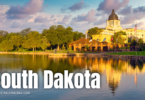The state capital of Montana is the city of Helena. Helena is also the county seat of Lewis and Clark County. With a population of about 28,000 people, it is the fifth least populous state capital in the nation, while being the sixth most populous city in Montana. It is the primary city in the Helena Micropolitan Statistical Area. This area includes all of Lewis and Clark County and Jefferson County. The population of the overall area is about 77,000.
Long before the European settlers came to Helena, the area was inhabited by a variety of Native American tribes. Archaeological evidence on either side of the Elkhorn Mountains, which are southeast of the Helena Valley, shows that the area was once inhabited by the Folsom culture. Other Native tribes who lived in the area after the Folsom people were the Salish and the Blackfeet. The horse was introduced to the area about three hundred years ago and has been used by Native tribes in the area since then. Later tribes appear to have lived in the area seasonally, as they made their nomadic rounds of their hunting grounds.
The first people of European descent came to the Helena area in the early 1800s, arriving from both the United States and Canada to work on the Missouri watershed streams as they searched for fur animals like beavers, so they could trap them and sell their pelts back east and abroad. No one stayed for long, much like the Native tribes of the time. At first, the Helena area was not an inviting place to live for long periods.
People of European descent began to stay longer in the area with the discovery of gold in the early 1860s. The gold discovered in Idaho Territory attracted migrants from all across the United States and Canada. The city of Helena was founded to be a camp for gold miners during the Gold Rush and was established in 1864. There was a lot of gold in Helena. In fact, more than $3.6 billion worth of gold was mined within the Helena city limits over a twenty year period. Because so much wealth was produced in Helena, it became a prominent Western city, with elaborately designed buildings with distinctive and attractive Victorian architecture going up in the city limits during this time.
Eventually, so many people came to Helena and the general Montana area because of the gold rush that the US government created the Montana Territory in May of 1864. In the fall of that year, when the population of the area that would become Helena reached more than two hundred, some residents thought the name of the camp, which was called Last Chance Gulch at the time, was too crass, and a new name was warranted. There were seven self-appointed men who met to name the town, as well as to authorize the way the streets would be laid out, and to elect city commissioners.
These men suggested the name Tomah, which was a word that was connected with the local Native people. Other members of the committee suggested names such as Pumpkinville and Squashtown. This was because their meeting was on the day before Halloween. Others wanted to name the town after other towns in Minnesota, where many of the committee had come from. Names like Winona and Rochester were suggested. A man from Scotland who was on the committee suggested the name Helena, which would be in honor of the Helena Township in Scott County, Minnesota. It would be pronounced He-LEE-na.
The former Confederate soldiers in the room liked the name but not the pronunciation. They insisted if this name were chosen, that it be pronounced like the town of Helena, Arkansas, which was pronounced He-li-na. After the vote, the name Helena won for the name of the town, but the way it was pronounced was not settled upon at that time, and it varied among speakers until 1882 when the He-li-na pronunciation became the dominant one in the city. After that, the town was always called Helena, pronounced He-li-na.
The town of Helena was surveyed for the first time in 1865 by Captain John Wood. Quite a few of the original streets of the city were chaotic in nature, following the paths the miners made as they walked around gold claims and navigated the winding gulch nearby. Because of this, while some of the city blocks have a consistent size to them, they vary widely in shape, and some groups even have an interesting variety of irregular shapes.
A man named Henry D. Washburn was appointed Surveyor General of Montana in 1869, and he set up the Washburn Langford Doane Expedition in Helena. The expedition was to explore the area that would later become Yellowstone National Park. Mount Washburn, which is today located in Yellowstone, is named after him. Nathaniel P. Langford, who was a former US Collector of Internal Revenue for Montana Territory helped Washburn publicize the amazing things they discovered at Yellowstone. The park was officially established in May of 1872, and Langford was appointed as the first superintendent of the Department of the Interior.
Gold made Helena wealthy. In 1888, about fifty millionaires lived there, which was more millionaires per capita than any city on the planet at that time. All of them were rich because of gold. Most of the gold production in Helena happened before 1868, though a bit happened after. Most of the former mines in the city limits are now underneath the streets and buildings of Helena. There is some gold there still. In the 1970s, a vein of gold was found when repairs were being made to the foundation of a local bank.
The influence of gold can still be seen in Helena today. Its fine homes and intricate architecture reflect the very best of Victorian building standards of the time. Anyone who comes to Helena today can see firsthand the influence of gold and what it can do for a city.





